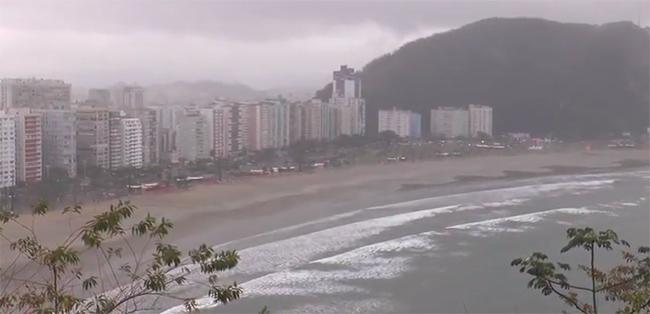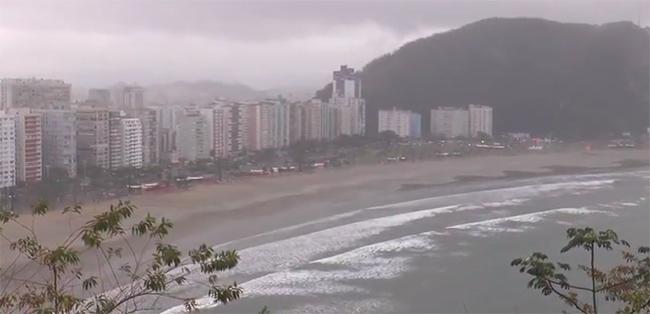
Credit: Agência FAPESP
Coastal cities deal with the constant fear that sea levels should continue to rise in the years ahead due to climate change. In the case of Santos, home of Latin American's biggest harbor, a study supported by the São Paulo Research Foundation (FAPESP) estimated that, by 2100, sea level might be 45 cm higher and not only will storm surges be more frequent, but they will reach peaks that might surpass current peak levels in 20 cm.
Co-supported by the Belmont Forum – a global initiative that also design adaptive strategies in the coastal locations of Selsey (United Kingdom city) and Broward (a county in Florida, US) – the study titled Project Metropolis defined minimum costs so that Santos may adapt itself for what's ahead: approximately R$ 300 million worth of urban infrastructure renovations in Ponta da Praia area and also in its Northwest region. On the other hand, failure to adapt to climate change would cost at least R$1.5 billion
"However, the cost could be underestimated at R$1.5 billion because the model only considers physical buildings and other structures, and the calculations are based on their imputed or taxable values. If we included losses in other areas, such as health and education, for example, the value would easily reach R$3 billion," said José Marengo, coordinator of Project Metropolis (http://bv.fapesp.br/en/auxilios/81993/).
Luiz Eduardo Oliveira e Cruz de Aragão, an investigator at Brazil's National Space Research Institute (Inpe) and also a member of the project, sheds light on the broad impact of climate change on the health sector. Risk analysis and the investigation of adaptive strategies, according to Aragão, identified a connection between El Niño and the rising number of dengue cases in the summers of 2010 and 2015 – in these years, the expenditure on patient hospitalizations and treatments in Santos rose by at least R$720,000.
"We estimated some of the impacts on health, but if all diseases linked to rising temperatures and flooding are factored in, we can see the real impact of this problem in the area of health," said the researcher.
Future scenario points to the increase of floods
Sea levels in Santos have risen at different rates since the 1940s. "Based on time series, we identified two possible scenarios for the city. One is more realistic, with sea levels rising by 0.36 cm per year. The other is the worst-case scenario, with sea levels rising by 0.45 cm per year. The conclusion was that sea levels could rise between 18 cm and 23 cm by 2050, and between 36 cm-45 cm by 2100," said Celia Regina de Gouveia Souza, a researcher at the Geologic Institute (IG) of the Sao Paulo State a member of the project team.
The model also considers the occurrence of extreme events, such as meteorological tides and storm surges, which are increasingly frequent because of climate change and result in rapid rises in sea level.
According to Gouveia Souza, who maintains a database of the occurrences of extreme events harking back to the late twenties (1928-2016) in the whole Santos city area (the so-called Baixada Santista region), the frequency of storm surges has increased significantly, as has the number of consecutive years with storm surges, since the late 1990s.
"The Santos tide gauge data tables show that the peak rise during one of these extreme events in the 2000s was 146 cm," she said. "According to our projections, it could reach 160 cm in 2050 and 166 cm in 2100. This means that the city will be even more vulnerable to coastal floods and erosion, which will migrate toward Bairro do Embaré (Canal 4 surroundings)."
Having produced the coastal flooding scenarios for 2050 and 2100 and having calculated the potential damages to buildings, the researchers shared their findings with the population of Santos and the local government to discuss appropriate adaptive measures.
"Options for adaptation were brought up at these town hall meetings," Marengo said. "One option is fortification using revetments, seawalls, and structural enhancements. In other cases, it's possible to opt for beach replenishment. Another strategy we see as necessary for Santos is mangrove rehabilitation, which can be classified as an ecosystem-based adaptation."
"The measures chosen by the public were quite adequate. We hope the project will continue under the aegis of the local authorities with ongoing popular participation. If so, the worst-case scenario is much less likely to materialize," said Luci Hidalgo Nunes, a researcher at UNICAMP and a project team member.
The city of Santos was chosen by the Project Metropolis team not just for its economic importance but also because its tidal, rainfall, temperature and storm surge data time series are the best among Brazil's coastal cities.
"Although scientists and decision makers must discuss adaptations, it has to be public policy. It must come from the government," Marengo said. "It's an action that cannot stop and obviously there must be an investment. Santos has achieved a high level of awareness, with a broad dialogue involving the public, decision makers, and academia. The construction projects must be implemented. The worst thing that could happen would be if it all stayed on the drawing-board."
###
Project Metropolis produced four years of studies and gathered scientists from the Natural Disaster Surveillance & Early Warning Center (CEMADEN), IG, the University of São Paulo (USP) and the University of Campinas (UNICAMP). The group developed three lines of research: estimating economic losses and adaptive capacities; extreme weather modeling; and health impacts. Their scenarios considered projections for 2050 and 2100.
About São Paulo Research Foundation (FAPESP)
The São Paulo Research Foundation (FAPESP) is a public institution with the mission of supporting scientific research in all fields of knowledge by awarding scholarships, fellowships, and grants to investigators linked with higher education and research institutions in the State of São Paulo, Brazil. FAPESP is aware that the very best research can only be done by working with the best researchers internationally. Therefore, it has established partnerships with funding agencies, higher education, private companies, and research organizations in other countries known for the quality of their research and has been encouraging scientists funded by its grants to further develop their international collaboration. For more information: http://www.fapesp.br/en.
Media Contact
Heitor Shimizu
[email protected]
55-113-838-4223
@AgencyFAPESP
http://www.fapesp.br
Original Source
http://agencia.fapesp.br/26110/





